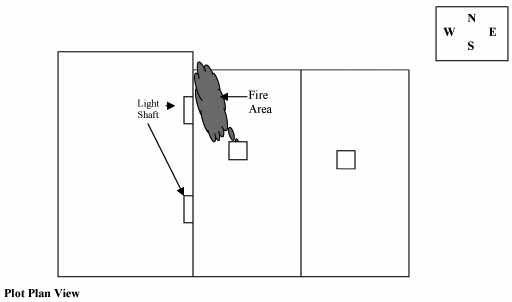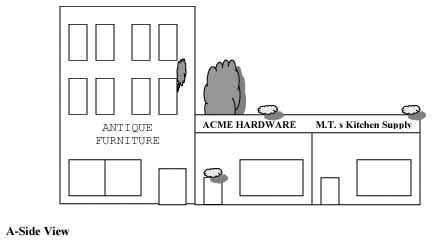Promotional Scenario #2
Promotional Scenario #2
Attention New Jersey Lt./Captain test candidates:
With your written and oral assessment exam approaching, Promotional Prep students are reminded of the need to pay specific attention to incident/exercise, the text content and accompanying diagrams, the question(s) design and intent, and your role within the exercise. Promotional exams are designed to measure the knowledge, skills, and abilities of a test candidate within the job analysis for that position. Top scoring students will tell you that their success was not only related to a significant knowledge base of the test subject areas, but their ability to comprehend the exercise, the questions, and their responsibilities. Keep that in mind as we continue with your preparation. Continued success!
![]()
At 18:30 hours on Friday September 1st., an alarm is transmitted for a reported fire at 349 Central Ave.
Pre-incident information for 349 Central Ave. identifies the building as a 30’x100′, one-story, ordinary constructed (Class 3) hardware store with standard flat roof and a three foot high parapet wall. Surrounding properties are:
- Exposure B – 3-story frame residential (4 apt.s) over a commercial antique furniture store.
- Exposure D – Kitchen supply store that is a similar attached structure with a common/shared cockloft.Arriving on the scene you observe fire inside the rear of 349 Central Ave. concentrated in the B/C corner, with a smoke condition throughout the store. A light haze of smoke is also visible in the D exposure. You notice the furniture store is closed. Numerous occupants are at the windows above the store curious as to all the commotion. Initial reports indicate all occupants have evacuated the hardware store except for the owner who is gathering receipts from the register. All patrons have evacuated the kitchen supply store; however, several workers still remain.It is a cloudy day with light rain and a temperature of 82 degrees. Wind is 15 mph out of the east gusting to 20 mph.
Multiple Choice Questions:
1. Of the following weather conditions, which is most critical?
a. Wind
b. Temperature
c. Humidity
d. Precipitation2. Which of the following will be your priority exposure?
a. Exposure B
b. Exposure D
c. Both B and D are equally critical.
d. Exposure C3. Interior units indicate that fire has spread up into the cockloft. The most appropriate location for a vent hole to be cut at this fire is?
a. Directly over the fire
b. Close proximity to the fire toward the D exposure
c. Given construction, location and extent of fire, no vertical ventilation should be accomplished.
d. Trench cut along the D side to prevent extension4. Heated fire gasses rising and causing ignition of the cockloft is an example of which method of heat transfer?
a. Flying brands
b. Radiation
c. Convection
d. Conduction5. Companies assigned to the roof with the objective of vertical roof ventilation are designated as?
a. Roof Group
b. Roof Division
c. Division 2
d. Roof Command6. The greatest concern with fire venting out the front show window(s) in this type structure is?
a. Fire extension into cockloft
b. Fire extending laterally along the parapet
c. Collapse of the parapet wall
d. Radiated heat7. What is the horizontal collapse danger of the parapet wall in this scenario
a. 25 feet
b. 30 feet
c. 60 feet
d. 100 feetMultiple Choice Answers:
1. A – Wind is 15-20 mph. Although the temperature is 82 degrees prompting early relief and rehab, winds over 10 mph present a concern in any attached building scenario. Add the fact that the wind is out of the east blowing toward the occupied exposure… and your concerns increase significantly.
2. A – Note the quote, “Numerous occupants are at the windows above the store curious as to all the commotion”.
3. B – Cutting the ventilation hole directly over the fire in this scenario will allow involvement of the attached, occupied exposure. Add the fact of a 20 mph wind blowing from the east again, and your need to not only ventilate the fire building, but also prevent fire spread to the attached and higher exposure building has to be factored into your decision-making.
4. C – Answer is based on your knowledge of basic fire behavior.
5. B – Answer is based on your understanding of management terms and their meanings within the Incident Management System.
6. C – You have to expect that any significant amount of fire exiting a display/show window in a Class 3 designed building will affect the steel lintel and the integrity of the parapet wall above.
7. C – The parapet wall in this exercise/diagram is common/shared between the fire building and the “D” exposure building. With the fire building measure 30’x100′ and the “D” exposure measuring the same, the horizontal collapse hazard of the parapet wall is equal to 60 feet.
Oral Assessment Question:
As the Company Officer assigned to oversee roof operations, your report to the Incident Commander should describe conditions and any observations that would alert or assist with fireground operations. As the officer in-charge of the Roof Division, what will your “roof report”consist of?
- Size and shape of fire building and attached/nearby exposures
- Smoke/fire volume and intensity other than the command side
- Location and involvement of any light and air-shafts
- Observations and indications of fire present in the cockloft
- Location of any dividing walls separating stores
- Heavy loads on the roof deck (i.e. A/C, Refrigeration, ventilation units, etc.)
- Accessibility to the rear
- Exposure concerns in the rear
- Life hazard concerns in the rear
- Differences in levels of the roof deck surface anywhere within the square footage of the complex, which may indicate a structural add-on.
- Location of any structural add-ons.
- Roof actions taken.
- Roof actions completed.
- Other creditable responses:
References:
- Promotional Prep, Lt./Captain Promotional seminars
- Fireground Size-Up, Terpak – Jersey City
- Collapse of Burning Buildings, Dunn – New York


